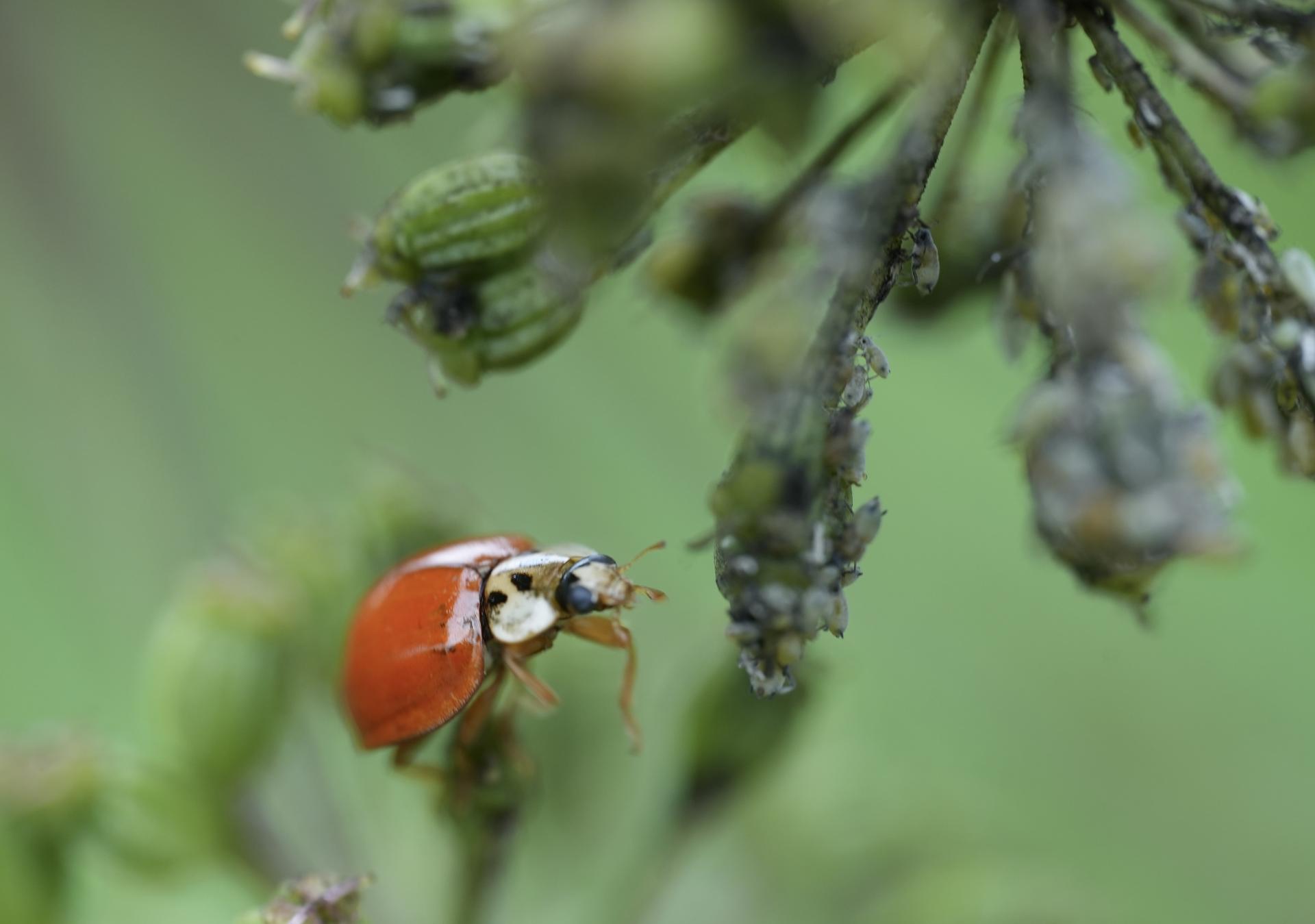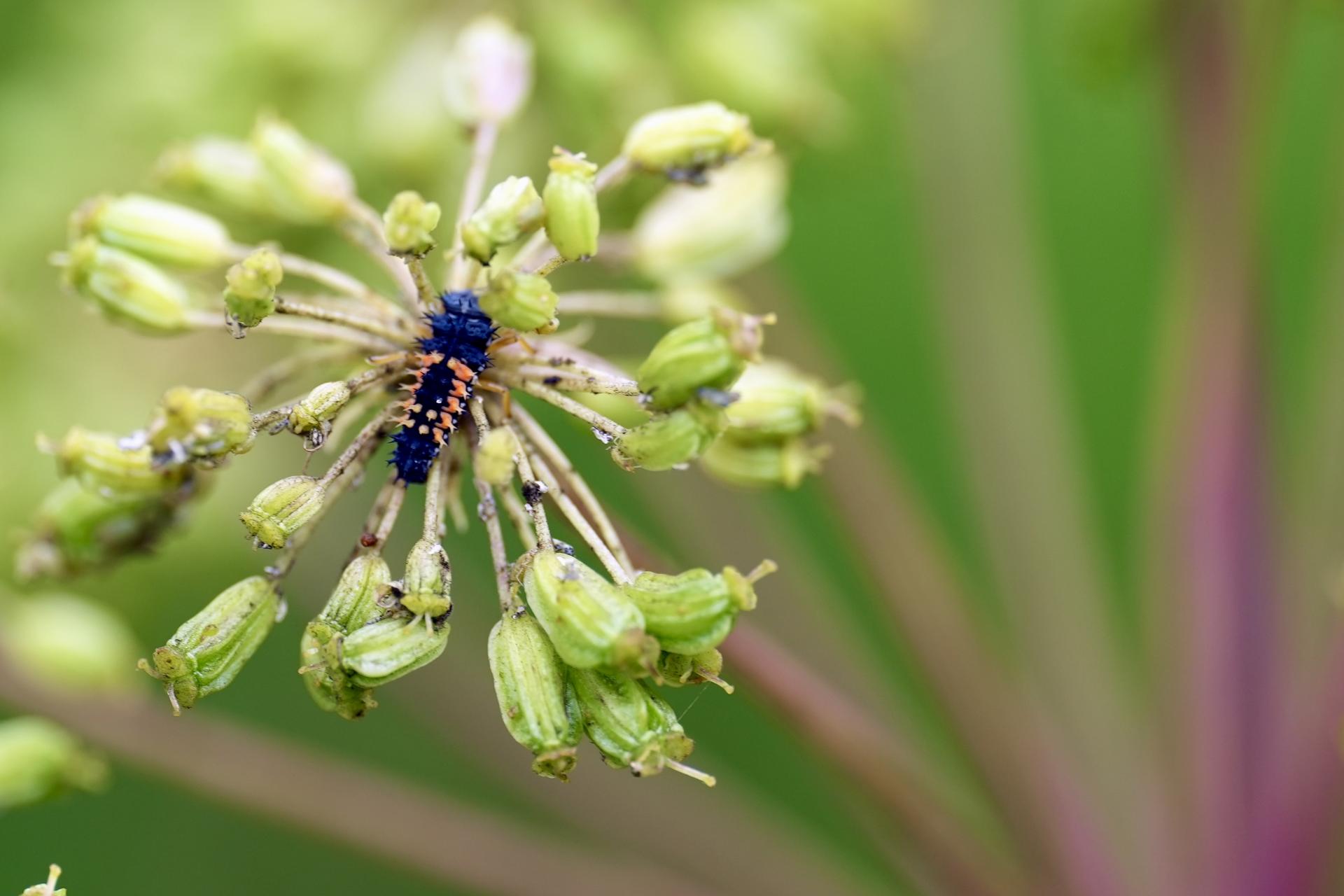You are here
What's Happening in the BBG Herb Gardens and Kitchen? Ladybugs!
What's Happening in the BBG Herb Gardens and Kitchen? Ladybugs!
By Barbara Smith
The Herb Associates are happy to report the sighting in the Herb Display Garden of lady beetles, also known as “ladybugs” or “ladybird beetles.” One of the volunteers spotted the insects on the Angelica plant in the Display Garden (by the Center House). Lady beetles are usually red or orange with black dots or other markings, the number of which may vary with the variety.
Lady beetles are among the most visible and best known beneficial predatory insects. Hundreds of species are found in America, most of which are native. As it turns out, the variety discovered in the Herb Display Garden is the multicolored Asian ladybug, a non-native variety now common throughout the United States. It is highly-variable in appearance, colored orange, reddish orange or sometimes tan, with various number of spots. It is usually larger than native lady beetle varieties.
Most lady beetles are beneficial both as adults and larvae, for growers of vegetables, grains, legumes, strawberries and trees. Any crop that is attacked by aphids will benefit from these beetles. In addition, lady beetles may occasionally supplement their diet by feeding on pollen or nectar, particularly that found on the shallow blossoms of angelica, calendula, coreopsis, cosmos, dill, chives, marigolds and yarrow. By planting these flowers or crops, you may be able to attract lady beetles to your garden.
Female lady beetles may lay hundreds of eggs during a three-month period. The eggs are usually deposited on the underside of leaves near prey such as aphids. Like all beetles, lady beetles undergo “complete metamorphosis” — their lifecycle begins with an egg, which hatches to become a larva that feeds, transitioning to a pupa where changes occur, and ultimately ends as an adult. Many common lady beetles are thought to have only one generation per year, synchronized with the flush of aphid populations occurring in spring.
Lady beetles are voracious eaters and may be numerous where prey are plentiful and broad-spectrum insecticide use is limited. A lady beetle may eat its weight in aphids every day as a larva and consume as many as 50 aphids per day as an adult. Once they have eliminated an aphid colony, lady beetles will search for additional food such as scales, spider mites, or mealybugs. Birds are the main predators of lady beetles, which also are victims of wasps, spiders and dragonflies.
Some nurseries and garden catalogs offer lady beetles for control of garden pests. However, the record for effective use of lady beetles released in a garden is often poor, since lady beetles introduced to a garden may fly away to other sites. Asian ladybeetles can be a nuisance in the autumn, when they may gather on the outside of buildings seeking overwintering sites. If they do enter your home, sweep or vacuum them up and take them outside. There are no repellants to make the insects leave; preventing entry (by sealing cracks or spaces) is the most effective step to protect your home.
“The Grouchy Ladybug” by Eric Carle, a popular children’s picture book, provides a science lesson about the role of ladybugs eating aphids to protect leaves and the importance of being polite. (You can visit the Eric Carle Museum in Amherst, Mass.) It may be of interest to know that, decades ago, the lady beetle was adopted as the official State insect of Massachusetts and its neighbor, New York (among other states).
We hope this information regarding lady beetles will inspire you to encourage them to your gardens.
The Berkshire Botanical Garden’s Herb Associates began in 1957 and have been making and selling products for the benefit of BBG ever since. At BBG, the Herb Associates oversee a display garden and production garden, both located near the Center House. Members/volunteers meet every Tuesday morning during the late spring through mid-autumn each year, coinciding when the gardens themselves are open to the public. Members plant, weed and tend the gardens, as well as harvest and process the variety of herbs.
Help Our Garden Grow!
Your donation helps us to educate and inspire visitors of all ages on the art and science of gardening and the preservation of our environment.
All donations are 100 percent tax deductible.





